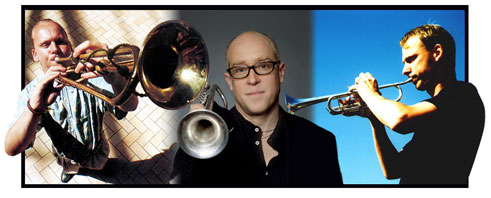Instrumental Insights: The Trumpet by Amy Horvey
/ October 1, 2011
Version française...
Flash version here.

A brief history of
the trumpet
Early History
The trumpet has taken on so many different forms over its long history
that it can be hard to define what the instrument actually is. In the
Renaissance and Baroque periods you can find trumpets made of wood,
slide trumpets, coiled “hunting” trumpets—but what was most common
seems to have been a long metal lip-blown tube that could only play
the notes of the natural harmonic series. This focus on natural tones
means that the trumpet often symbolizes the divine, or God as the King
of the world in Baroque music; you can often hear this in Bach’s cantatas.
The tromba,
as the Italians called it, was played by special trumpet guilds which
came out of medieval metal working guilds. They had deep links with
the aristocratic and military worlds, and no royal court was complete
without a corps of trumpeters. The fact that the Baroque trumpet is
staggeringly difficult to play also has something to do with this. It’s
always very interesting to read treatises from the Baroque which discuss
the social world of the trumpeter. Johann Ernst Altenberg’s treatise,
for example, advises the correct way for a trumpet to carry a message
to enemy lines and notes that a trumpeter “shall and must live in
grand style, especially when he is young and single.”
By the end of the
18th century trumpets were being built with keyholes, clockwork
slide mechanisms, and tuning holes, but it was the introduction of piston
valves in the early 19th century that really created the
modern trumpet, making it possible to play chromatically in all keys.
Still, the Baroque trumpet has a special timbre and mystique that makes
it an essential instrument in its own right.
Modern Mastery
A trumpet with piston valves can do things that the Baroque trumpeters
could only dream of: play in all keys, chromatically, and with an amazing
range. With the mass production techniques of the Industrial Revolution,
it wasn’t long before the trumpet became an instrument not restricted
to the aristocracy, but played by colliery bands, amateur ensembles,
orchestras, and modern military bands.
Still, while the
trumpet leads the 19th century orchestral brass section,
there’s surprisingly little Romantic solo music in its repertoire.
However, after the pioneering work done by John Philip Sousa’s lead
cornettist, Herbert L. Clarke, and early jazz performers like Bix Beiderbecke
and Louis Armstrong, the trumpet began to come into its own as a solo
instrument in the 20th century. The technological and technical
possibilities of the trumpet are still growing, as well the possibilities
that come from combining the instrument with electronics. Trumpet repertoire
is rapidly expanding, and it’s a field in which there is still much
important research to be done.
Some of the most
interesting work being done by trumpeters today comes from the early
music movement, where new information about ancient times is constantly
changing how we approach the instrument. And it would be remiss to ignore
the important contributions being made by players from jazz, free improvisation,
and non-Western traditions.
|
Buzz off!
The production of sound
on a brass instrument, such as the trumpet, is achieved by blowing air
through “m” shaped lips, or “buzzing” into the mouthpiece. Through
changes of embouchure (the position, tension and flexibility of the
lips in relation to the mouthpiece) overtones and harmonics are created
which allow for changes of pitch. The size, shape and dimensions of
the mouthpiece used directly affect the resulting timbre of the instrument.
These elements also influence facility and comfort for the player.
|
Amy Horvey’s Trumpet
Tips
For the beginner
What would you consider to be an important, yet often overlooked
element of instrument care that trumpeters should follow in order to
maintain their instrument?
Get your trumpet cleaned and calibrated regularly by a professional!
It's a precision instrument and having everything tuned up and in working
order can make a big difference. I go to Ron Partch Brasswind in Toronto,
who uses ultrasound vibrations to internally clean the horn; hi-tech
stuff.
For the intermediate
What is an essential daily routine that intermediate-level trumpeters
should have in their arsenal to maintain and further develop their playing?
Practice in 20-minute increments, making sure that you rest as much
as you play. Practice your fundamentals: air flow exercises, lip flexibilities,
scales, and Clarke studies.
For the advanced
What would you recommend as a potentially inexpensive way to
upgrade a trumpet for someone who may not be able to afford a professional
instrument?
You can try second-hand instruments. Fortunately, trumpets are relatively
cheap instruments and you can find an inexpensive horn that can last
a lifetime!
If you could recommend
one work and recording that would romance anyone into falling in love
with the trumpet, what would it be and why?
Giacinto Scelsi's phantasmic
Quattro pezzi would have to be my choice. It's a piece from the
1950s and there are not many recordings available, so I can't resist
blowing my own horn, so to speak, and recommending my own recording
on my album Interview, released on the Malasartes Musique label.
Trumpeter Amy Horvey
regularly works with the National Arts Centre and Montreal Symphony
Orchestras. She has appeared in festivals including the Montreal Baroque
Festival, the Ottawa Chamber Music Festival, and the 2010 Vancouver
Cultural Olympiad, and has worked with leading early music ensembles
including Ensemble Caprice and the Studio de Musique Ancienne de Montréal.
She teaches at Concordia University. amyhorvey.com
|
Did You Know?
While the trumpet was
still trying to find its identity through the 18th century,
two works left their mark and continue to be significant pieces of the
repertoire: a trumpet concerto by Franz Joseph Haydn (1796) and another
by Johann Nepomuk Hummel (1803). Both works were written for Austrian
trumpet virtuoso Anton Weidinger.
|
Version française... | 

